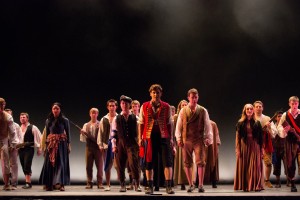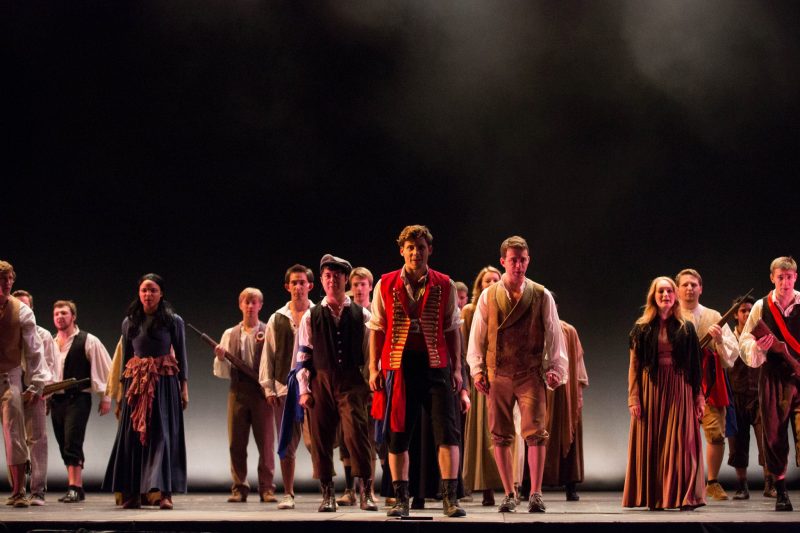
The Ram’s Head Theatrical Society’s production of Victor Hugo’s beloved “Les Miserables” reimagines the musical by extending the theater to the audience and beyond the stage. Memorial Auditorium was carefully decorated to resemble a 19th century opera house, and throughout the play actors performed on and off the stage, many times blurring the line between stage and audience.
The production included a special immersive reception called the Opera Going Experience Project. Half an hour before the show began, actors dressed as 19th century operagoers swept into a courtyard. Ladies in dresses trimmed with lace and adorned with satin ribbons clustered together in groups, gossiping while fanning their powdered faces. Men dressed as the bourgeoisie stood tweaking their mustachios or smoking cigars while discussing politics. Audience members were free to weave through the actors, stopping to listen in on a conversation or admire costumes. Candles placed in white paper bags lined the courtyard, shedding a soft glow on the scene.
A stone corridor connected the courtyard to Memorial Auditorium, which – in keeping with the setting of a 19th century Parisian opera house –featured thick velvet drapery adorning the stage and even an orchestra pit. The bourgeois operagoers from the courtyard eventually entered the auditorium and took their seats amongst the audience.
This production achieved a strong connection between the audience and the action on stage. In the opening scene, prisoners formed two lines in the aisles of the seating area, crying forth their lamentations while Javert stood hawk-like on the stage. A smaller stage protruded from the main stage where actors delivered their soliloquys in close proximity to the audience. The audience was able to see the actor’s expressions and better feel the presence of Cossette’s misery, Eponine’s heartbreak, Javert’s horrifying disillusionment and Jean Valjean’s steadfast faith. There was also a live orchestra, which underscored the actors’ powerful voices.
Beautiful set designs, costumes and a masterful use of lighting also enhanced the emotional involvement of the viewers. Large wooden boxes were arranged in different ways throughout the play, allowing for smooth transitions between scenes. Sets were placed on a rotating floor, shifting the audience’s perspective to provide optimal views. A diversity of intricate costumes were used. Twinkling lights were draped in the background as Javert delivered his “Stars” soliloquy. Brilliant flashes illuminated Jean Valjean running frantically in the tunnels, searching for a way out. An eerie bluish light fell upon the corpses scattered on the barricades.
The play ended again with the actors performing off-stage in the audience. Actors moved from all corners of the auditorium, eventually coalescing on stage where they triumphantly performed the famous finale, “Do You Hear the People Sing.” Watching the actors move around and sing amongst the audience in the final scene completed the intended emotional impact of the play.
This innovative take on “Les Miserables” frequently placed the viewer at an interesting intersection between emotional involvement and a consciousness of his place as a viewer. The show immersed the audience in the world of Victor Hugo, allowing for a deeper engagement with the heart-rending emotions of the play that make us return to it time and time again.
Contact Atussa Hamamoto Mohtasham at amohtash “at” stanford.edu.
